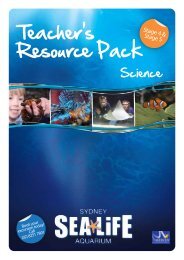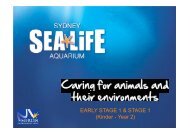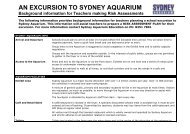Teacher's Resource Pack - Sydney Aquarium
Teacher's Resource Pack - Sydney Aquarium
Teacher's Resource Pack - Sydney Aquarium
You also want an ePaper? Increase the reach of your titles
YUMPU automatically turns print PDFs into web optimized ePapers that Google loves.
Living Creatures<br />
Understanding the different life processes and being able to work out whether an object<br />
is living or not is vital to life science. These resources will help your students to grasp<br />
the meaning of the life processes. They are also encouraged to look more closely at<br />
nutrition, seeing how each animal is suited to catching the food it eats. A visit to SEA<br />
LIFE <strong>Sydney</strong> can be a great introduction to the topic, or give your students a chance to<br />
reinforce their learning in this topic.<br />
<strong>Resource</strong>s provided<br />
Lesson 4: What’s for dinner?<br />
Learning objectives<br />
● Know what the key life<br />
processes are.<br />
● Know that a living thing must<br />
demonstrate all of the life<br />
processes.<br />
● Know how to tell the difference<br />
between animals and plants.<br />
Student Worksheets 4-5<br />
Living Creatures PowerPoint slides<br />
Pre & Post Lessons<br />
Lesson 1: Living creatures<br />
Use the slides 1-7 to introduce students<br />
to the fact that all humans and animals<br />
grow, feed, reproduce, eat and use their<br />
senses.<br />
Students to look at Student Worksheet<br />
4, which contains these life processes as<br />
key words and mixed up descriptions.<br />
Students should match the key words to<br />
the descriptions.<br />
Use Slide 8 to reveal the answers.<br />
<strong>Resource</strong>s:<br />
Slides 1-8<br />
Student Worksheet 4<br />
Lesson 2: Am I living<br />
Students to complete the table on<br />
Student Worksheet 5 for each of the<br />
living and non-living objects listed.<br />
They should work out if the object is<br />
living or not by putting a tick or a cross<br />
against some of the different life<br />
processes i.e. grow, feed, reproduce,<br />
sense and move.<br />
Students may need help deciding on the<br />
answer for some objects.<br />
<strong>Resource</strong>s:<br />
StudentWorksheet 5<br />
Lesson 3: Excursion to<br />
SEA LIFE <strong>Sydney</strong> <strong>Aquarium</strong><br />
During your visit<br />
Students could list the living and<br />
non-living things in the rock pool during<br />
their visit.<br />
Students could find out what the<br />
different creatures in the touch pool eat.<br />
Using the slides, explain that all animals<br />
eat different foods and that often their<br />
bodies are specially adapted to help<br />
them catch their food.<br />
Conduct the quiz on slides 10-29 as a<br />
class.<br />
Display the picture and description of<br />
the animal and ask students to choose<br />
which of the animals shown below it<br />
eats.<br />
Click on the answer to find out whether<br />
it is correct.<br />
If PowerPoint facilities are not available<br />
you could print out copies of the slides<br />
before the lesson.<br />
<strong>Resource</strong>s:<br />
Slides 9-29<br />
Lesson 1: Living collage<br />
Students can make a collage to celebrate<br />
all of the different types of living things<br />
that exist in the world’s oceans.<br />
They should make sure to include plants,<br />
mammals and reptiles as well as fish.<br />
<strong>Resource</strong>s:<br />
Sources for downloading images<br />
Syllabus areas<br />
● Science and Technology<br />
● Visual Art<br />
● English<br />
Wow facts!<br />
● Sharks have been around longer<br />
than dinosaurs, over 350 million<br />
years!<br />
● Turtles are ancient reptiles -<br />
they’ve been around for 200<br />
million years and can live to be<br />
100 years old!<br />
● If a sea star loses an arm, it just<br />
grows another one!<br />
● Catfish are covered in taste buds,<br />
which helps them to find food in<br />
muddy water.<br />
4








